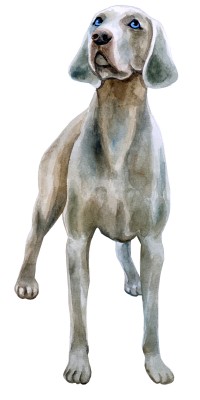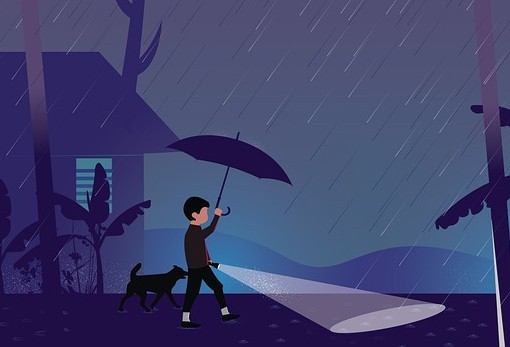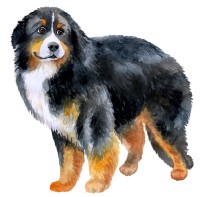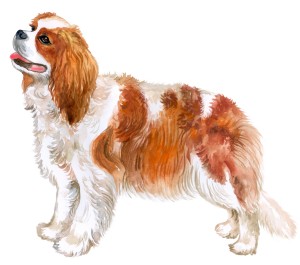Teach Your Pup to Go to the Bathroom Outdoors
By Michele Welton, Dog Trainer, Breed Selection Consultant, Author of 15 Dog Books
If you skipped ahead to this article, please go back and read the previous article on Housebreaking Basics. Important stuff there!
Teaching your pup to go to the bathroom outside is best done using a crate plus frequent trips outdoors.
 With this method, you take your pup outside, on leash, to a specific potty area, and you reward him when he eliminates there.
With this method, you take your pup outside, on leash, to a specific potty area, and you reward him when he eliminates there.
The more frequently you take him out, the faster he will learn. The minimum should be every 2 hours, plus as soon as he wakes from sleeping/napping, as soon as he finishes eating, and whenever he begins to walk in a small circle and sniff the floor. In the beginning, if you can manage every hour, that's even better!
The rest of the day and night, you confine him safely in a crate so he never has the chance to practice bad habits on the floors of your house. During the housebreaking period, he should be confined in his crate unless you're sitting with him, playing with him, walking him, or otherwise interacting with him.
He should never be loose in the house.
Sample housebreaking routine
The alarm wakes you at 6 am. Immediately you throw on clothes (drape them over a handy chair the night before!) and head for your pup's crate where he spent the night. But first, listen: is he quiet? You'll remember from my article on crate training that you should never let him out while he's barking.
If he's barking, you'll need to wait him out. Stay out of sight until he has been quiet for at least a couple of minutes. Then walk to his crate in a nonchalant manner. Once he sees you, he'll be excited. Don't speak to him or he might pee right then and there! Arghh!
 So say nothing other than a calm greeting: "Hi Jake." Open the crate door and say "Okay." As he starts through, quickly attach his leash, which you were smart enough to place on top of his crate when you put the pup to bed.
So say nothing other than a calm greeting: "Hi Jake." Open the crate door and say "Okay." As he starts through, quickly attach his leash, which you were smart enough to place on top of his crate when you put the pup to bed.
As you let your QUIET dog out of the crate, don't pet him or play with him. Depending on how large/old he is, you might scoop him up and carry him, or you might let him walk. Either way, it's time for "You need to go OUT? Time to go OUT."
Immediately head for the door – always use the same door – to his potty area. First thing in the morning, get him out there as quickly as you can without running!
Don't send a non-housebroken pup out in the yard to "go" on his own. This is one of the biggest mistakes owners make.
Unleashed dogs will run around and play instead of doing their business. And if they do "go" and you're not right there to praise and reward the pup, you've missed a critical opportunity to reinforce the right behavior.
Always go to the same place in your yard.
You might need to experiment to find out where your pup eliminates best:
- Most dogs prefer grass but they might dislike wet grass, or long grass, or short prickly grass. Most enjoy sniffing around on grass, which can be a good thing because sniffing often leads to finding "the right spot". On the flip side, some pups get too preoccupied with sniffing and lose focus on doing their business. For extremely sniffy, distractible pups, you might need a non-grass potty area.
- Many dogs like dirt, but not when it's muddy.
- Gravel might, or might not, be okay, depending on how comfortable it is to walk on.
- Most pups dislike doing their business on concrete, perhaps because it holds fewer interesting scents? But if you live in the city, concrete might be all that's available and your dog will need to get used to it.
- Some pups want privacy. They feel exposed out in the open and prefer to slip behind a bush or close beside a fence or wall.
- Some pups can't concentrate if there's activity going on nearby (for example, if there's a school across the street and the kids are out playing). Dogs who tend to gawk or bark at stuff need a quiet, boring spot.
- Some pups are too intimidated to eliminate if they can see another dog or hear one barking.

- Some dogs, especially toy breeds, HATE rain or snow with a passion – I usually end up making a covered potty area for these little guys.
So find a spot where your pup does well and try to use that spot throughout the housebreaking process. Having his own urine or stool scent in that place will remind him that this is where he eliminates.
What to do when you get there
Say in a pleasant voice, "Find a spot" or "Go potty." Use a calm, pleasant, encouraging voice, not stern or commanding. Your pup needs to feel relaxed in order to be able to go!
Important... what NOT to do!
- Don't let your pup off the leash. This isn't playtime. It's a potty break routine.
- Stand still. Root your feet in one place. Don't take your pup for a walk when you're housebreaking him. Walk briskly to the right spot, encourage your dog to go, then stand still.
- Don't make eye contact or he will pay attention to you instead of concentrating on doing his business.
- Don't say anything to him, except to occasionally repeat your potty phrase. Other talking will only distract him.
 Just stand there silently. Look off in the distance or count the clouds. Watch your pup out of the corner of your eye. Hopefully, he will wander around you in a circle, sniffing the ground. If he sits or lies down or stands motionless, take a few steps in order to get him up and moving. Then stand still again.
Just stand there silently. Look off in the distance or count the clouds. Watch your pup out of the corner of your eye. Hopefully, he will wander around you in a circle, sniffing the ground. If he sits or lies down or stands motionless, take a few steps in order to get him up and moving. Then stand still again.
If you walk around, he will look at these outings as a time for exploration and play rather than dedicated bathroom breaks. This is also why you use a 6-foot leash rather than a longer one. There are plenty of spots he can "go" within the length of a 6-foot leash.
How long should you stand there?
First thing in the morning, he should need to pee and poop.... unless he has already gone in his crate overnight.
- Let's think positively! Let's say he kept his crate clean all night. Now you know he needs to both pee and poop. So you should stay outside with him as long as it takes. Fortunately it usually doesn't take long.
- If he peed overnight in his crate, but didn't poop, he should be needing to do that now.
- Finally, if he both peed and pooped in his crate overnight.... oh well. He may or may not need to "go" now. So keep an eye on the time. If after 10 minutes, he hasn't (at least) peed, bring him back inside and put him in his crate for 5 or 10 minutes. Then try him outside again. If you're persistent, he will learn that he must go to the bathroom – even a token drop or two – before he is allowed to run and play.
After a successful potty break
If and when he finally does go, praise him, "Good boy, go potty" AS he is going. You want to attach that phrase to the very act of eliminating.
 Wait until he is completely finished, then reach into your pocket and pull out a treat. (If he sees the treat beforehand, or even if he sees your hand in your pocket, he might get distracted before he's done.) Give him the treat with lots of praise: "Yay! Good boy to go potty! Yay!"
Wait until he is completely finished, then reach into your pocket and pull out a treat. (If he sees the treat beforehand, or even if he sees your hand in your pocket, he might get distracted before he's done.) Give him the treat with lots of praise: "Yay! Good boy to go potty! Yay!"
If the weather is good, play with him for a few minutes – his reward for a successful potty break.
If you're in a safely fenced yard AND if he always comes when you call, you can let him off leash to romp and play.
Otherwise leave the leash on and let him drag it around. Or switch to a 15- or 20-foot leash to keep control while giving him more room.
After a successful potty break and activity session, give your pup a drink of water and put him in his crate or pen.
For the last potty break of the day, I aim for 11 pm.
IMPORTANT: Keep a written log of every potty break and its result, including the time. Something simple like: Tue, Jun 6, 6am, 1, 2 (where 1 is urination and 2 is defecation).
My best-selling books – now available FREE on my website
 Respect Training For Puppies: 30 seconds to a calm, polite, well-behaved puppy is for puppies 2 to 18 months old. Your puppy will learn the 21 skills that all family dogs need to know. Click here to read for free.
Respect Training For Puppies: 30 seconds to a calm, polite, well-behaved puppy is for puppies 2 to 18 months old. Your puppy will learn the 21 skills that all family dogs need to know. Click here to read for free. Teach Your Dog 100 English Words is a unique Vocabulary and Respect Training Program that will teach your adult dog to listen to you and do what you say. Click here to read for free.
Teach Your Dog 100 English Words is a unique Vocabulary and Respect Training Program that will teach your adult dog to listen to you and do what you say. Click here to read for free. 11 Things You Must Do Right To Keep Your Dog Healthy and Happy helps your dog live a longer, healthier life. Get my honest advice about all 11 Things before you bring home your new puppy, because some mistakes with early health care cannot be undone. Click here to read for free.
11 Things You Must Do Right To Keep Your Dog Healthy and Happy helps your dog live a longer, healthier life. Get my honest advice about all 11 Things before you bring home your new puppy, because some mistakes with early health care cannot be undone. Click here to read for free.
